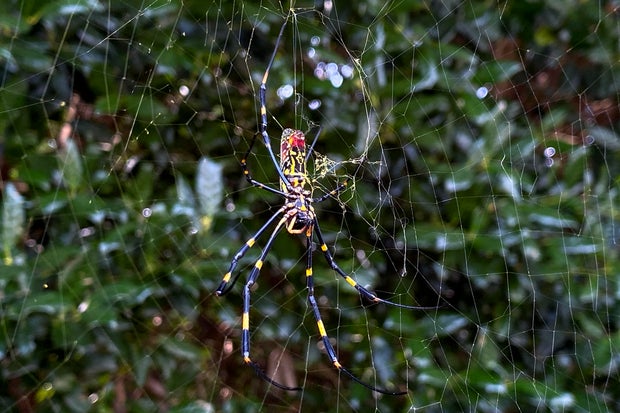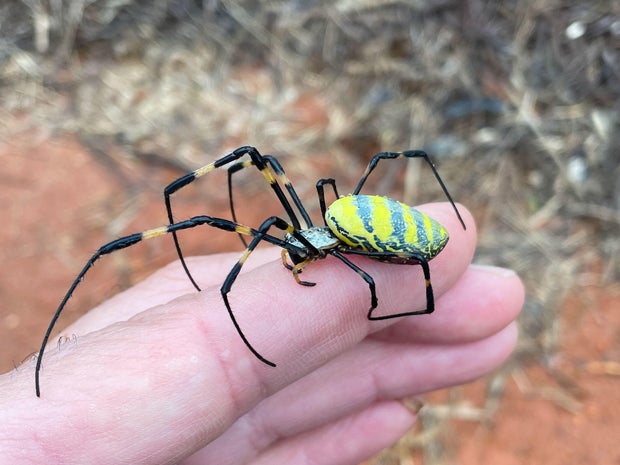The saga of the large invasive Joro spiders that parachute through the air isn’t over. A new study found that the critters with 4-inch-long legs are truly built differently, with hearts that are able to withstand the loud and bustling noises of big cities.
University of Georgia researcher Andy Davis made the discovery while conducting cardiac stress tests on Joro spiders and their cousin, the golden silk spider. The research, published in Physiological Entomology on Monday, found that the species know how to chill out and stay calm when put in heart rate-raising situations.
The Joro spider, also known as Trichonephila clavata, “is known for making webs not only in natural green spaces but also in cities and towns, often on buildings and human dwellings,” the study says. “The stress reactions of Trichonephila spiders could be characterized as ‘even-tempered,’ which may factor into their ability to live in habitats with frequent disturbances.”
Davis and his team evaluated the physiological reactions of Joro spiders and golden silk spiders and compared them to those of another pair of similarly-sized species that are related to each other, garden spiders and banded garden spiders.
Researchers recorded baseline heart rates of the arachnids while they were resting and inactive, and then recorded their heart rates after restraining them under electronic sensors for 10 minutes.
Alex Sanz / AP
“When subjected to the novel restraint stress, heart rates of all spider species became elevated, which is an expected reaction that other spider researchers have noted,” the study says. “However, there were differences among species in the magnitude of this elevation, and of how the responses progressed during the 10 min period.”
The garden spiders, both of which belong to the Argiope genus, showed “distinct periods of fluctuations during the restraint” and were even found to struggle against the restraints, researchers said. Joro spiders and their golden silk cousins, on the other hand, were “less variable and more even.” They were also observed entering a state of thanatosis for more than an hour after stressors, meaning they essentially froze up during that time.
The tests “are beginning to paint a picture of how the invasive Joro spider and its cousin, the golden silk spider, have a unique way of tolerating novel stressors, which may be the reason for their ability to occupy anthropogenic landscapes,” researchers said, noting that other spider species in their family line could share this trait, although that would need further investigation.
Joro spiders have been making headlines for years as they continue to spread up the East Coast. Originally from Asia, the spiders are believed to have been first introduced to north Georgia around 2010. They have since been found across nearly a dozen other states. In December, Davis told The New York Times that New York is “right in the middle of where they like to be.” It’s been predicted that they could pop up in the New York tri-state area this summer, although no reports of such have been made.
Dave Coyle/Clemson University
“They seem to be OK with living in a city,” he told the paper, adding that they’ve been seen hanging out on street lamps and telephone poles, where “regular spiders wouldn’t be caught dead in.”
The latest findings may not definitively prove that the spiders’ relaxed demeanor is the reason for “their affinity for urban settings,” the study says, adding that more research is needed. It does, however, bolster Davis’ research from February, which also found that Joro spiders don’t necessarily mind the increased noise and vibrations that come with city living.
“These Joro webs are everywhere in the fall, including right next to busy roads, and the spiders seem to be able to make a living there. For some reason, these spiders seem urban tolerant,” Davis said of his earlier research.
UGA student and co-author of that study, Alexa Schultz, agreed, saying, “It looks like Joro spiders are not going to shy away from building a web under a stoplight or an area where you wouldn’t imagine a spider to be.”
But don’t worry — while the spiders are venomous, they don’t pose a danger to humans, although they may elevate your heart rate more than you elevate theirs.



